Investigating a Dataset: Movies
Introduction
What are the properties of high revenue films? Using data from The Movie Database (TMDb), I investigated the relationship between popularity, runtime, and vote average (rating) and the adjusted revenue of the films. To account for inflation, the adjusted revenue column reflects a film’s revenue in 2010 dollars.
- Has film revenue changed over time?
- Are high revenue films more popular than low revenue films?
- Is there a positive relationship between runtime and revenue? Is it worth it to produce a long film?
- Are high revenue films highly rated?
import pandas as pd
import numpy as np
import matplotlib.pyplot as plt
import seaborn as sns
%matplotlib inline
df_movies = pd.read_csv(r"C:\Users\bsear\Desktop\Class Assignments\movies.csv")
df_movies.head(1)
| id | imdb_id | popularity | budget | revenue | original_title | cast | homepage | director | tagline | ... | overview | runtime | genres | production_companies | release_date | vote_count | vote_average | release_year | budget_adj | revenue_adj | |
|---|---|---|---|---|---|---|---|---|---|---|---|---|---|---|---|---|---|---|---|---|---|
| 0 | 135397 | tt0369610 | 32.985763 | 150000000 | 1513528810 | Jurassic World | Chris Pratt|Bryce Dallas Howard|Irrfan Khan|Vi... | http://www.jurassicworld.com/ | Colin Trevorrow | The park is open. | ... | Twenty-two years after the events of Jurassic ... | 124 | Action|Adventure|Science Fiction|Thriller | Universal Studios|Amblin Entertainment|Legenda... | 6/9/2015 | 5562 | 6.5 | 2015 | 137999939.3 | 1.392446e+09 |
1 rows × 21 columns
Data Wrangling
A quick review of the dataset tells me what data types I have, if there are null values, and what kind of clean-up, if any, is needed before evaluation.
At first glance, it appears that all of the variables I want to investigate are populated with data. Before I take a closer look at those columns, I removed the columns “ID”, “IMDB ID”, “Homepage”, “Tagline”, and “Overview”. Since I am not using those variables in my evaluation, I took those out in order to keep the dataframe tidy and easy to read.
I kept other columns, such as titles, directors, cast, genres, production companies, and release dates in case those variables provide additional insights later on.
After closer inspection, I had to clean the runtime and adjusted revenue columns.
#what does my dataset look like?
df_movies.info()
<class 'pandas.core.frame.DataFrame'>
RangeIndex: 10866 entries, 0 to 10865
Data columns (total 21 columns):
# Column Non-Null Count Dtype
--- ------ -------------- -----
0 id 10866 non-null int64
1 imdb_id 10856 non-null object
2 popularity 10866 non-null float64
3 budget 10866 non-null int64
4 revenue 10866 non-null int64
5 original_title 10866 non-null object
6 cast 10790 non-null object
7 homepage 2936 non-null object
8 director 10822 non-null object
9 tagline 8042 non-null object
10 keywords 9373 non-null object
11 overview 10862 non-null object
12 runtime 10866 non-null int64
13 genres 10843 non-null object
14 production_companies 9836 non-null object
15 release_date 10866 non-null object
16 vote_count 10866 non-null int64
17 vote_average 10866 non-null float64
18 release_year 10866 non-null int64
19 budget_adj 10866 non-null float64
20 revenue_adj 10866 non-null float64
dtypes: float64(4), int64(6), object(11)
memory usage: 1.7+ MB
#Removing extraneous data columns here
df_movies.drop(['id', 'imdb_id', 'homepage','tagline','overview'], axis=1, inplace=True)
df_movies.head()
| popularity | budget | revenue | original_title | cast | director | keywords | runtime | genres | production_companies | release_date | vote_count | vote_average | release_year | budget_adj | revenue_adj | |
|---|---|---|---|---|---|---|---|---|---|---|---|---|---|---|---|---|
| 0 | 32.985763 | 150000000 | 1513528810 | Jurassic World | Chris Pratt|Bryce Dallas Howard|Irrfan Khan|Vi... | Colin Trevorrow | monster|dna|tyrannosaurus rex|velociraptor|island | 124 | Action|Adventure|Science Fiction|Thriller | Universal Studios|Amblin Entertainment|Legenda... | 6/9/2015 | 5562 | 6.5 | 2015 | 137999939.3 | 1.392446e+09 |
| 1 | 28.419936 | 150000000 | 378436354 | Mad Max: Fury Road | Tom Hardy|Charlize Theron|Hugh Keays-Byrne|Nic... | George Miller | future|chase|post-apocalyptic|dystopia|australia | 120 | Action|Adventure|Science Fiction|Thriller | Village Roadshow Pictures|Kennedy Miller Produ... | 5/13/2015 | 6185 | 7.1 | 2015 | 137999939.3 | 3.481613e+08 |
| 2 | 13.112507 | 110000000 | 295238201 | Insurgent | Shailene Woodley|Theo James|Kate Winslet|Ansel... | Robert Schwentke | based on novel|revolution|dystopia|sequel|dyst... | 119 | Adventure|Science Fiction|Thriller | Summit Entertainment|Mandeville Films|Red Wago... | 3/18/2015 | 2480 | 6.3 | 2015 | 101199955.5 | 2.716190e+08 |
| 3 | 11.173104 | 200000000 | 2068178225 | Star Wars: The Force Awakens | Harrison Ford|Mark Hamill|Carrie Fisher|Adam D... | J.J. Abrams | android|spaceship|jedi|space opera|3d | 136 | Action|Adventure|Science Fiction|Fantasy | Lucasfilm|Truenorth Productions|Bad Robot | 12/15/2015 | 5292 | 7.5 | 2015 | 183999919.0 | 1.902723e+09 |
| 4 | 9.335014 | 190000000 | 1506249360 | Furious 7 | Vin Diesel|Paul Walker|Jason Statham|Michelle ... | James Wan | car race|speed|revenge|suspense|car | 137 | Action|Crime|Thriller | Universal Pictures|Original Film|Media Rights ... | 4/1/2015 | 2947 | 7.3 | 2015 | 174799923.1 | 1.385749e+09 |
#checking to see if there are duplicates and removing them
df_movies.drop_duplicates(inplace=True)
sum(df_movies.duplicated())
0
#check for null values, particularly in my chosen variables
list(df_movies.isnull().sum().items())
[('popularity', 0),
('budget', 0),
('revenue', 0),
('original_title', 0),
('cast', 76),
('director', 44),
('keywords', 1493),
('runtime', 0),
('genres', 23),
('production_companies', 1030),
('release_date', 0),
('vote_count', 0),
('vote_average', 0),
('release_year', 0),
('budget_adj', 0),
('revenue_adj', 0)]
#before starting my analysis, I want to investigate the lack of null-values just a little more.
#this serves as a double check.
df_movies.describe()
| popularity | budget | revenue | runtime | vote_count | vote_average | release_year | budget_adj | revenue_adj | |
|---|---|---|---|---|---|---|---|---|---|
| count | 10865.000000 | 1.086500e+04 | 1.086500e+04 | 10865.000000 | 10865.000000 | 10865.000000 | 10865.000000 | 1.086500e+04 | 1.086500e+04 |
| mean | 0.646446 | 1.462429e+07 | 3.982690e+07 | 102.071790 | 217.399632 | 5.975012 | 2001.321859 | 1.754989e+07 | 5.136900e+07 |
| std | 1.000231 | 3.091428e+07 | 1.170083e+08 | 31.382701 | 575.644627 | 0.935138 | 12.813260 | 3.430753e+07 | 1.446383e+08 |
| min | 0.000065 | 0.000000e+00 | 0.000000e+00 | 0.000000 | 10.000000 | 1.500000 | 1960.000000 | 0.000000e+00 | 0.000000e+00 |
| 25% | 0.207575 | 0.000000e+00 | 0.000000e+00 | 90.000000 | 17.000000 | 5.400000 | 1995.000000 | 0.000000e+00 | 0.000000e+00 |
| 50% | 0.383831 | 0.000000e+00 | 0.000000e+00 | 99.000000 | 38.000000 | 6.000000 | 2006.000000 | 0.000000e+00 | 0.000000e+00 |
| 75% | 0.713857 | 1.500000e+07 | 2.400000e+07 | 111.000000 | 146.000000 | 6.600000 | 2011.000000 | 2.085325e+07 | 3.370173e+07 |
| max | 32.985763 | 4.250000e+08 | 2.781506e+09 | 900.000000 | 9767.000000 | 9.200000 | 2015.000000 | 4.250000e+08 | 2.827124e+09 |
#even though the previous null data check came back as 0 for my chosen variables, the describe function shows
#that my minimum value for revenue_adj is 0 - which seems odd. Here I take a closer look
null_data=df_movies[df_movies.isnull().any(axis=1)]
null_data.head(1)
| popularity | budget | revenue | original_title | cast | director | keywords | runtime | genres | production_companies | release_date | vote_count | vote_average | release_year | budget_adj | revenue_adj | |
|---|---|---|---|---|---|---|---|---|---|---|---|---|---|---|---|---|
| 130 | 1.284541 | 0 | 4719695 | True Story | Jonah Hill|James Franco|Felicity Jones|Maria D... | Rupert Goold | NaN | 100 | Crime|Drama|Mystery | Plan B Entertainment|Regency Enterprises|New R... | 4/17/2015 | 354 | 6.0 | 2015 | 0.0 | 4342117.489 |
#why does the runtime column have 0 as a minimum runtime?
df_movies[df_movies['runtime']==df_movies['runtime'].min()].head(1)
| popularity | budget | revenue | original_title | cast | director | keywords | runtime | genres | production_companies | release_date | vote_count | vote_average | release_year | budget_adj | revenue_adj | |
|---|---|---|---|---|---|---|---|---|---|---|---|---|---|---|---|---|
| 92 | 1.876037 | 0 | 0 | Mythica: The Necromancer | Melanie Stone|Adam Johnson|Kevin Sorbo|Nicola ... | A. Todd Smith | sword|magic|sorcery|necromancer | 0 | Fantasy|Action|Adventure | Arrowstorm Entertainment|Camera 40 Productions... | 12/19/2015 | 11 | 5.4 | 2015 | 0.0 | 0.0 |
#The other variables in the table indicate that those films with "0" runtime must actually be null values
#Here I replaced the '0' values with null
df_movies['runtime'].replace(0, np.nan, inplace=True)
df_movies['runtime'].describe()
count 10834.000000
mean 102.363855
std 30.948225
min 2.000000
25% 90.000000
50% 99.000000
75% 112.000000
max 900.000000
Name: runtime, dtype: float64
#this is a variable I plan to use in my analysis, so I am replacing those null values with the mean runtime
#this allows me to compare the same number of movies across my variables
runtime_mean=df_movies['runtime'].mean()
df_movies['runtime'].fillna(runtime_mean, inplace = True)
df_movies['runtime'].describe()
count 10865.000000
mean 102.363855
std 30.904039
min 2.000000
25% 90.000000
50% 99.000000
75% 111.000000
max 900.000000
Name: runtime, dtype: float64
#why does the adjusted revenue column have 0 as a minimum value?
#Just like with runtime, the adjusted revenue column also has '0' values where null is more appropriate
df_movies[df_movies['revenue_adj']==df_movies['revenue_adj'].min()].head(1)
| popularity | budget | revenue | original_title | cast | director | keywords | runtime | genres | production_companies | release_date | vote_count | vote_average | release_year | budget_adj | revenue_adj | |
|---|---|---|---|---|---|---|---|---|---|---|---|---|---|---|---|---|
| 48 | 2.93234 | 30000000 | 0 | Wild Card | Jason Statham|Michael Angarano|Milo Ventimigli... | Simon West | gambling|bodyguard|remake | 92.0 | Thriller|Crime|Drama | Current Entertainment|Lionsgate|Sierra / Affin... | 1/14/2015 | 481 | 5.3 | 2015 | 27599987.86 | 0.0 |
#The other variables in the table indicate that those films with "0" adjusted revenue must actually be null values
#Here I am replacing the '0' values with null
df_movies['revenue_adj'].replace(0, np.nan, inplace=True)
df_movies['revenue_adj'].describe()
count 4.849000e+03
mean 1.151009e+08
std 1.988557e+08
min 2.370705e+00
25% 1.046585e+07
50% 4.395666e+07
75% 1.316482e+08
max 2.827124e+09
Name: revenue_adj, dtype: float64
#Now I am determining the mean adjusted revenue and replacing the null values with the mean
revenue_adj_mean=df_movies['revenue_adj'].mean()
df_movies['revenue_adj'].fillna(revenue_adj_mean, inplace = True)
df_movies['revenue_adj'].describe()
count 1.086500e+04
mean 1.151009e+08
std 1.328386e+08
min 2.370705e+00
25% 5.878518e+07
50% 1.151009e+08
75% 1.151009e+08
max 2.827124e+09
Name: revenue_adj, dtype: float64
#now I have the same number of non-null values for the characteristics I want to test.
df_movies.info()
<class 'pandas.core.frame.DataFrame'>
Int64Index: 10865 entries, 0 to 10865
Data columns (total 16 columns):
# Column Non-Null Count Dtype
--- ------ -------------- -----
0 popularity 10865 non-null float64
1 budget 10865 non-null int64
2 revenue 10865 non-null int64
3 original_title 10865 non-null object
4 cast 10789 non-null object
5 director 10821 non-null object
6 keywords 9372 non-null object
7 runtime 10865 non-null float64
8 genres 10842 non-null object
9 production_companies 9835 non-null object
10 release_date 10865 non-null object
11 vote_count 10865 non-null int64
12 vote_average 10865 non-null float64
13 release_year 10865 non-null int64
14 budget_adj 10865 non-null float64
15 revenue_adj 10865 non-null float64
dtypes: float64(5), int64(4), object(7)
memory usage: 1.4+ MB
Exploratory Data Analysis
After an initial cleanup of my data, I can now begin my data analysis to answer my research questions:
- 1. Has film revenue changed over time?
- 2. Are high revenue films more popular than low revenue films?
- 3. Is there a positive relationship between runtime and revenue?
- 4. Are high revenue films highly rated?
1. Has film revenue changed over time?
Are movies making more money now than in the past?
#initial scatter plot
#I referenced the matplotlib.org page to learn the syntax for .set_xlabel
film_plot = df_movies.plot(x='release_year', y='revenue_adj',
title='Adjusted Revenue of Films Over Time', kind='scatter');
film_plot.set_xlabel('Release Year')
film_plot.set_ylabel('Adjusted Revenue in 2010 Dollars')
Text(0, 0.5, 'Adjusted Revenue in 2010 Dollars')

This chart visually represents every film in the dataset and its adjusted revenue. At first glance, this chart shows a higher number of films produced in later decades, as well as a number of outliers in each year. It is not, however, very clear to me if there is an obvious trend in this chart. I will need to create a better visual. I have over 10,000 records, so I will need to organize the films into broader categories, such as decades.
#Here I will cut the values into decades based on release year
bin_edges=[1960, 1970, 1980, 1990, 2000, 2010, 2020]
bin_names=['1960s', '1970s', '1980s', '1990s', '2000s', '2010s']
df_movies['release_decade']=pd.cut(df_movies['release_year'], bin_edges, labels=bin_names)
df_movies.head(1) #testing what it looks like
| popularity | budget | revenue | original_title | cast | director | keywords | runtime | genres | production_companies | release_date | vote_count | vote_average | release_year | budget_adj | revenue_adj | release_decade | |
|---|---|---|---|---|---|---|---|---|---|---|---|---|---|---|---|---|---|
| 0 | 32.985763 | 150000000 | 1513528810 | Jurassic World | Chris Pratt|Bryce Dallas Howard|Irrfan Khan|Vi... | Colin Trevorrow | monster|dna|tyrannosaurus rex|velociraptor|island | 124.0 | Action|Adventure|Science Fiction|Thriller | Universal Studios|Amblin Entertainment|Legenda... | 6/9/2015 | 5562 | 6.5 | 2015 | 137999939.3 | 1.392446e+09 | 2010s |
#pie chart visual
film_pie = df_movies['release_decade'].value_counts().plot(kind='pie',
title='Count of Films Released per Decade');
film_pie.set_ylabel(" ")
Text(0, 0.5, ' ')

In this pie chart, I wanted to see if there were more film releases in certain decades to confirm my initial impression from the scatter plot. It shows an increase in the number of films released each decade.
#to prepare for my descriptive bar chart, I start by calucalting
#the mean revenue for the decades
decade_revenue_means = df_movies.groupby('release_decade')['revenue_adj'].mean()
decade_revenue_means
release_decade
1960s 1.486290e+08
1970s 1.520075e+08
1980s 1.066893e+08
1990s 1.173703e+08
2000s 1.118565e+08
2010s 1.102115e+08
Name: revenue_adj, dtype: float64
#then organize my data into the chart
locations = [1,2,3,4, 5, 6]
heights = decade_revenue_means
labels = ['1960s', '1970s', '1980s', '1990s', '2000s', '2010s']
plt.bar(locations, heights, tick_label=labels)
plt.title('Mean Adjusted Revenue by Decade')
plt.xlabel('Decade')
plt.ylabel('Mean Adjusted Revenue in 2010 Dollars')
Text(0, 0.5, 'Mean Adjusted Revenue in 2010 Dollars')
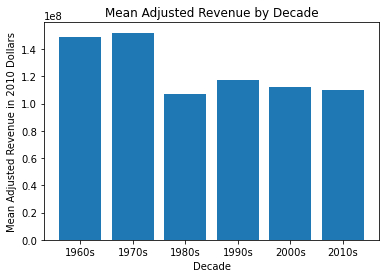
Thought: It appears that, while there are more movies made in later decades, the mean adjusted revenue is higher for earlier films. I decided to create this kind of visualization to compare the adjusted revenue means. The pie chart was interesting, but it really focused on the count of movies. The scatter plot showed every film and it’s adjusted revenue, but looking at individual films in this way is too detailed. This bar chart is a great visual to show, regardless of number of films produced each decade, which decade had the highest mean adjusted revenue. In short, it’s a single visual that answers my question.
- This is a visualization I really like and plan to use again, so I will make a function here to reduce the repetition of the lengthy code.
#defining my function
def bar_plot(locations, heights, labels, xlabel, ylabel, title):
plt.bar(locations, heights, tick_label=labels)
plt.xlabel(xlabel)
plt.ylabel(ylabel)
plt.title(title)
#creating a list of labels
decades = list(df_movies['release_decade'].unique().dropna())
decades.sort(reverse=False)
decades
['1960s', '1970s', '1980s', '1990s', '2000s', '2010s']
#running my new function
bar_plot([1,2,3,4,5,6], decade_revenue_means, decades,'Decades',
'Mean Adjusted Revenue in 2010 Dollars', 'Mean Adjusted Revenue by Decade')
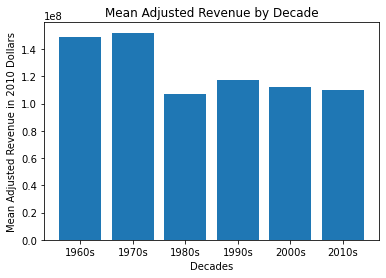
2. Are high revenue (adj) films more popular than low revenue films?
How popular are the high revenue films? Are they more or less popular than low revenue films?
#Information about the 'popularity' variable
df_movies['popularity'].describe()
count 10865.000000
mean 0.646446
std 1.000231
min 0.000065
25% 0.207575
50% 0.383831
75% 0.713857
max 32.985763
Name: popularity, dtype: float64
df_movies['popularity'].plot(kind='hist', title= "Popularity");

#a closer look at the minimum value to better understand the variable
df_movies[df_movies['popularity']==df_movies['popularity'].min()]
| popularity | budget | revenue | original_title | cast | director | keywords | runtime | genres | production_companies | release_date | vote_count | vote_average | release_year | budget_adj | revenue_adj | release_decade | popularity_level | |
|---|---|---|---|---|---|---|---|---|---|---|---|---|---|---|---|---|---|---|
| 6181 | 0.000065 | 0 | 0 | North and South, Book I | Patrick Swayze|Philip Casnoff|Kirstie Alley|Ge... | NaN | NaN | 561.0 | Drama|History|Western | NaN | 11/3/1985 | 17 | 6.0 | 1985 | 0.0 | 1.151009e+08 | 1980s | NaN |
#Getting more information about what the 'popularity' variable means
df_movies.groupby('revenue_adj')['popularity'].mean()
revenue_adj
2.370705e+00 0.462609
2.861934e+00 0.552091
3.038360e+00 0.352054
5.926763e+00 0.208637
6.951084e+00 0.578849
...
1.907006e+09 2.563191
2.167325e+09 2.010733
2.506406e+09 4.355219
2.789712e+09 12.037933
2.827124e+09 9.432768
Name: popularity, Length: 4840, dtype: float64
In this case, I’m not sure that the variable ‘popularity’ is really understandable in its current format. I think I need to adjust the values into more meaningful phrases.
#changing the values into string labels
bin_edges=[0.000065, 0.207575, 0.383831, 32.985763]
bin_names=['Low', 'Moderate', 'High']
df_movies['popularity_level']=pd.cut(df_movies['popularity'], bin_edges, labels=bin_names)
df_movies.head(1) #testing what it looks like
| popularity | budget | revenue | original_title | cast | director | keywords | runtime | genres | production_companies | release_date | vote_count | vote_average | release_year | budget_adj | revenue_adj | release_decade | popularity_level | |
|---|---|---|---|---|---|---|---|---|---|---|---|---|---|---|---|---|---|---|
| 0 | 32.985763 | 150000000 | 1513528810 | Jurassic World | Chris Pratt|Bryce Dallas Howard|Irrfan Khan|Vi... | Colin Trevorrow | monster|dna|tyrannosaurus rex|velociraptor|island | 124.0 | Action|Adventure|Science Fiction|Thriller | Universal Studios|Amblin Entertainment|Legenda... | 6/9/2015 | 5562 | 6.5 | 2015 | 137999939.3 | 1.392446e+09 | 2010s | High |
I think my new column ‘popularity level’ better conveys the meaning from the ‘popularity’ column.
#build a visual to compare popularity and mean adjusted revenue
popularity_revenue_means = df_movies.groupby('popularity_level')['revenue_adj'].mean()
popularity_revenue_means
popularity_level
Low 1.013358e+08
Moderate 9.190113e+07
High 1.335833e+08
Name: revenue_adj, dtype: float64
#creating a list of labels
popularity_level = ['Low', 'Moderate', 'High']
popularity_level
['Low', 'Moderate', 'High']
#running my new function
bar_plot([1,2,3], popularity_revenue_means, popularity_level,'Popularity Level', 'Mean Adjusted Revenue in 2010 Dollars',
'Popularity of Films and Mean Adjusted Revenue')

Thought: Just like in my first question, I wanted to create a bar graph to answer my question. It’s an easy way to see the difference in popularity levels and film revenue, regardess of the number of films produced. It’s not particularly surprising that highly popular films also bring in the most revenues. It’s interesting, however, that low popularity films make more revenue than moderatly popular films.
3. Is there a positive relationship between runtime and revenue (adj)?
Do long movies make more money?
#Descriptive stats on the 'runtime' variable
df_movies['runtime'].describe()
count 10865.000000
mean 102.363855
std 30.904039
min 2.000000
25% 90.000000
50% 99.000000
75% 111.000000
max 900.000000
Name: runtime, dtype: float64
Just like ‘popularity’, I think looking at the length of a film in terms of minutes might not be meaningful #to people reading the information. For example, it’s easier to understand what 1 hour 40 minutes means #in terms of movie length compared to 100 minutes.
#quick review of my variable
df_movies['runtime'].plot(kind='hist', title="Movie Runtimes");
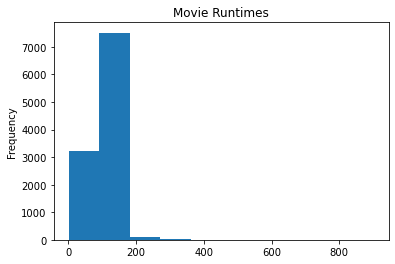
#Here I create a new measure for the movie runtimes
bin_edges=[0,90,99,111,900]
bin_names=['short', 'medium', 'moderately long', 'long']
df_movies['movie_length']=pd.cut(df_movies['runtime'], bin_edges, labels=bin_names)
df_movies.head(1) #testing what it looks like
| popularity | budget | revenue | original_title | cast | director | keywords | runtime | genres | production_companies | release_date | vote_count | vote_average | release_year | budget_adj | revenue_adj | release_decade | popularity_level | movie_length | |
|---|---|---|---|---|---|---|---|---|---|---|---|---|---|---|---|---|---|---|---|
| 0 | 32.985763 | 150000000 | 1513528810 | Jurassic World | Chris Pratt|Bryce Dallas Howard|Irrfan Khan|Vi... | Colin Trevorrow | monster|dna|tyrannosaurus rex|velociraptor|island | 124.0 | Action|Adventure|Science Fiction|Thriller | Universal Studios|Amblin Entertainment|Legenda... | 6/9/2015 | 5562 | 6.5 | 2015 | 137999939.3 | 1.392446e+09 | 2010s | High | long |
#How many of each movie length type
df_movies['movie_length'].value_counts()
short 2931
long 2710
medium 2651
moderately long 2573
Name: movie_length, dtype: int64
The number of films fall fairly evenly into each category of length
#As percentages to confirm my impression
(df_movies['movie_length'].value_counts()/df_movies['movie_length'].value_counts().sum())*100
short 26.976530
long 24.942476
medium 24.399448
moderately long 23.681546
Name: movie_length, dtype: float64
Is there a relationship between movie length and revenue?
#Calculating means for each length type
runtime_revenue_means = df_movies.groupby('movie_length')['revenue_adj'].mean()
runtime_revenue_means
movie_length
short 1.035472e+08
medium 9.980478e+07
moderately long 1.009606e+08
long 1.559853e+08
Name: revenue_adj, dtype: float64
#creating a list of labels
movie_lengths = list(df_movies['movie_length'].unique().dropna())
movie_lengths.sort(reverse=True)
movie_lengths
['short', 'moderately long', 'medium', 'long']
#running my function
bar_plot([1,2,3,4], runtime_revenue_means, movie_lengths,'Film Runtime',
'Mean Adjusted Revenue in 2010 Dollars', 'Mean Adjusted Revenue by Film Runtime')
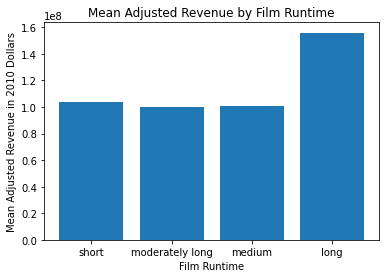
Thought: Again, using this kind of visualization is a great way to see where difference exists. A pie chart might also be an interesting visual for this output, as well; particularly since there is one value much greater than the rest. I a little suprrised by the result. There is clearly a jump in revenue for “long” films. “Long” films are at least 1 hour and 51 minutes long.
4. Are high revenue (adj) films highly rated?
Just because a movie makes a lot of money - does it mean that it’s also highly rated?
#Descriptive stats for the variable
df_movies['vote_average'].describe()
count 10865.000000
mean 5.975012
std 0.935138
min 1.500000
25% 5.400000
50% 6.000000
75% 6.600000
max 9.200000
Name: vote_average, dtype: float64
After looking at the descriptive stats for ‘vote average’, these values are a little more unclear at first glance. Some descriptive language might make the values have more meaning to readers.
#more context for my analysis
df_movies['vote_average'].plot(kind='hist', title="Vote Averages");

#again, creating descriptive values by defining bin edges and cutting the data into my new measures.
bin_edges=[1.5, 5.4,6.0,6.6,9.2]
bin_names=['low', 'medium', 'moderately high', 'high']
df_movies['voting_score']=pd.cut(df_movies['vote_average'], bin_edges, labels=bin_names)
df_movies.head(1)
| popularity | budget | revenue | original_title | cast | director | keywords | runtime | genres | production_companies | release_date | vote_count | vote_average | release_year | budget_adj | revenue_adj | release_decade | popularity_level | movie_length | voting_score | |
|---|---|---|---|---|---|---|---|---|---|---|---|---|---|---|---|---|---|---|---|---|
| 0 | 32.985763 | 150000000 | 1513528810 | Jurassic World | Chris Pratt|Bryce Dallas Howard|Irrfan Khan|Vi... | Colin Trevorrow | monster|dna|tyrannosaurus rex|velociraptor|island | 124.0 | Action|Adventure|Science Fiction|Thriller | Universal Studios|Amblin Entertainment|Legenda... | 6/9/2015 | 5562 | 6.5 | 2015 | 137999939.3 | 1.392446e+09 | 2010s | High | long | moderately high |
#creating means
vote_values_means = df_movies.groupby('voting_score')['popularity'].mean()
vote_values_means
voting_score
low 0.420572
medium 0.555395
moderately high 0.705920
high 0.930673
Name: popularity, dtype: float64
#creating a list of labels
scores = ['low', 'medium', 'moderately high', 'high']
scores
['low', 'medium', 'moderately high', 'high']
#running my function
bar_plot([1,2,3,4], vote_values_means, scores,'Voting Scores',
'Popularity', 'Relationship Between Voting Scores and Popularity')
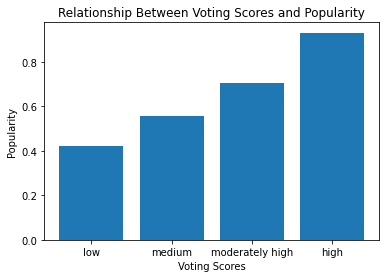
Thought: A detailed bar chart shows the relationship between voting scores (ratings) and popularity. It’s a clear trend indicating that popular films are highly rated by audiences. Does the same trend hold with another kind of visual?
#Scatter
popularity_plot = df_movies.plot(x='vote_average', y='popularity',
title="Vote Average and Popularity", kind='scatter');
popularity_plot.set_xlabel('Vote Average')
popularity_plot.set_ylabel('Popularity')
Text(0, 0.5, 'Popularity')

The trend holds within a scatter plot; while this kind of chart shows the outliers, the data clearly shows a positive relationship between vote average and popularity.
Conclusions
1. Has film revenue changed over time?
Yes, absolutely. I found it particularly interesting that the number of films being made has increased, but the revenue is down. Movies released in the 1960s and 1970s were fewer in number but earned more at the boxoffice. Why?
- Fewer TVs? Less at-home entertainment could explain why revenue was higher in teh 1960s and 1970s.
- The rise of the VHS in the 1980s and the prevalence of at-home movie consumption in the 1990s and 2000s could explain the drop in revenue despite the increased number of film releases.
Limitation: I am making an educated guess as to why films brought in higher revenue in the 1960s and 1970s. An additonal dataset with information about at-home entertainment systems would be an interesting evaluation. Is there a correlation?
Limitation: Were people going to the movies more often back in teh 1960s and 1970s? This dataset may record “popularity” but it doesn’t necessarily indicate how may people attended these movies.
2. Are high revenue films more popular than low revenue films?
As expected, yes, high revenue films are popular films. It is an easy assumption to make that, if people like a film, they will invest in it more, either by seeing it in the theatre multiple times and/or purchasing the film.
Limitation: high revenue films are popular, but are popular films high earners? It would be a good idea to confirm this. Are both variables predictors of the other?
Limitation: the variable “popularity” is a somewhat vague variable and I could not find much information online about how TMDb defines popularity. Is it the number of people who see the film? The number of times it plays? How many copies of the film people buy? How long the film is in theatres? Or is it another measure? While the relationship between popularity and revenue doesn’t change, the meaning of the results could change if the variable is more clearly defined.
3. Is there a positive relationship between runtime and revenue?
There is a positive relationship between runtime and revenue. You can clearly see in the bar graph how much higher revenue is for the “long” film runtime.
- I was surprised by this result at first, as I wasn’t sure there would be a well-defined relationship at all.
- I also expected that if there was a relationship, I didn’t think long films would necessarily be popular.
Limitations: Time is relative and subjective. Using runtime as a variable may be useful in determining the minimum and maximum film runtime to get the most return on investment, but people’s definitions of a “long” or “short” film may vary.
Liminations: After looking at the data more closely, 111 minutes (1 hour 51 minutes) isn’t really that long (to me). As I mentioned above, movie time length can be subjective and others may think a 2 hour film is long. If I did this analysis again, I might categorize the lengths differently or change the minute runtime into hour runtimes.
4. Are high revenue films highly rated?
Yes, high revenue films also receive high ratings. I was a little surprised at these findings; just because a movie brings in a lot of money doesn’t automatically make it a “good” film. Then again, this is a subjective measure.
Limitations: Just like with the “popularity” variable, TMDb doesn’t define “average rating” in this dataset. I made the assumption that it was a film rating.
Final Thoughts
This dataset was very interesting to work with and there are many ways to measure the characteristics of a high revenue film than the ones I used. If I were to do this project over, I would re-consider some of the variables I chose to evaluate my questions. The dataset could be improved with more information about some of the variables, such as popularity and average ratings. While the lack of a definition doesn’t affect the calculations, it can affect the story I tell with the data.